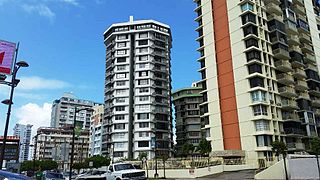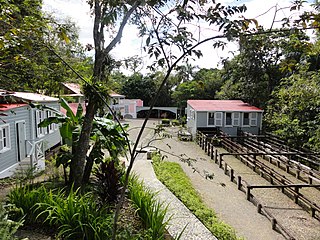
Carolina is a city and municipality located on the northeast coast of Puerto Rico. It lies immediately east of the capital San Juan and Trujillo Alto; north of Gurabo and Juncos; and west of Canóvanas and Loíza. Carolina is spread over 12 barrios plus Carolina Pueblo. It is part of the San Juan-Caguas-Guaynabo Metropolitan Statistical Area, and home to Puerto Rico's main airport, the Luis Muñoz Marín International Airport.

A hacienda is an estate, similar to a Roman latifundium, in Spain and the former Spanish Empire. With origins in Andalusia, haciendas were variously plantations, mines or factories, with many haciendas combining these activities. The word is derived from Spanish hacer and haciendo (making), referring to productive business enterprises.

Jíbaro is a word used in Puerto Rico to refer to the countryside people who farm the land in a traditional way. The jíbaro is a self-subsistence farmer, and an iconic reflection of the Puerto Rican people. Traditional jíbaros were also farmer-salesmen who would grow enough crops to sell in the towns near their farms to purchase the bare necessities for their families, such as clothing.

Hacienda Buena Vista, also known as Hacienda Vives, was a coffee plantation located in Barrio Magueyes, Ponce, Puerto Rico. The original plantation dates from the 19th century. The plantation was started by Don Salvador de Vives in 1833.
The Conservation Trust of Puerto Rico is a private, nonprofit organization protecting natural areas; constituting conservation easements; restoring, rehabilitating and preserving historical structures; developing educational programs that foster the protection of natural areas; and directing a tree nursery program for native and endemic species, among others. The Conservation Trust of Puerto Rico has been accredited by The Land Trust Accreditation Commission. The Conservation Trust is also a member of the International Union for Conservation of Nature, a global environmental organization with more than 1,200 public and private members from 160 countries.

Manuel V. Domenech Ferrer was a Puerto Rican politician and engineer. He was mayor of Ponce in 1904, and designer of Casa Armstrong-Poventud, Rosaly-Batiz House, and the 1898 Casas Gemelas built for Luis Casals, among others prominent structures.

The Mayor of Ponce is the head of government of Ponce, Puerto Rico. The current mayor is Luis Irizarry Pabón.
Salvador de Vives Rodó, also known as Salvador Vives, was a Puerto Rican hacendado and Mayor of Ponce, Puerto Rico, from 1 January 1840 to 5 January 1842 and then again from 1 January 1844 to 24 November 1845. His son, Carlos Vives, was a member of the Ponce Municipal Assembly.

Magueyes is one of the 31 barrios of the municipality of Ponce, Puerto Rico. Together with Cerrillos, Machuelo Arriba, Maragüez, Montes Llanos, Portugués, Sabanetas, and Tibes, Magueyes is one of the municipality's eight interior barrios. The name of this barrio is of native Indian origin. It was created in 1831.

Plaza Muñoz Rivera, formally Plaza Luis Muñoz Rivera, is the smaller of the two plazas at Plaza Las Delicias in the city of Ponce, Puerto Rico. It is located on the north side of Plaza Las Delicias, north of the larger southern Plaza Degetau. The square is notable for its fountains and for the Luis Muñoz Rivera statue. The historic Parque de Bombas and Ponce Cathedral buildings are located immediately to the south of Plaza Muñoz Rivera. The square is at the center of the Ponce Historic Zone, and is flanked by the Armstrong-Poventud Residence to the west, the Teatro Fox Delicias to the north, and Catholic University of Puerto Rico School of Architecture to the east. The square dates back to the early Spanish settlement in Ponce of 1670. It is the main tourist attraction of the city, receiving about a quarter of a million visitors per year.

Casa Vives is a historic building located in the Ponce Historic Zone in Ponce, Puerto Rico, across from the Plaza de Mercado de Ponce. The home was designed by Juan Bertoli Calderoni for Carlos Vives, a prominent local merchant and owner of Hacienda Buena Vista, and built by Carlos Milan. The home was built in 1860, in the neoclassical style, making it one of the first brick and mortar homes built in the city. It was added to the U.S. National Register of Historic Places on 13 February 2013. Architecturally, Casa Vives retains all seven aspects of integrity: location, design, setting, materials, workmanship, feeling and association.
The following is a timeline of the history of the city of Ponce, Puerto Rico.
José Concepción Benítez y Bermúdez was mayor of Ponce, Puerto Rico in 1800. He is best remembered for the creation of the Fuerte de San José in 1760 in Playa de Ponce. The fort was in operation until the 1890s.
Guillermo A. Baralt is a Puerto Rican historian. He obtained his bachelor's degree from Duquesne University in 1970. Later he continued his studies in the University of Chicago where he earned his Master's and Doctor's degrees. He is currently professor of History at the University of Puerto Rico at Rio Piedras. He is a member of Phi Sigma Alpha fraternity.

Museo Hacienda Buena Vista is a historic coffee plantation farm museum in Barrio Magueyes, Ponce, Puerto Rico. The museum opened in 1987, and receives some 40,000 visitors a year. The museum has been described as "Puerto Rico's first living museum of art and science."
Antonio Toro was Mayor of Ponce, Puerto Rico from 1833 to 1836.

El Rabanal is a small, protected area consisting of 16 acres of critical secondary forest in the municipality of Cidra, Puerto Rico. The forest tract is located in barrio Rabanal, in a 5,438-acre hydrological basin which is home to 21 species of birds, seven out of which are endemic to the region, including the Puerto Rican plain pigeon. This protected area was established through the Asociación de Pequeños Agricultores de Rabanal Inc. (APARI) and the Puerto Rico Conservation Trust in 2002 with the goal of protecting the area from urban development and developing educational programs related to sustainable agriculture and environmental education.

Italian Puerto Ricans are Puerto Rican-born citizens who are fully or partially of Italian descent, whose ancestors were Italians who emigrated to Puerto Rico during the Italian diaspora, or Italian-born people in Puerto Rico.












